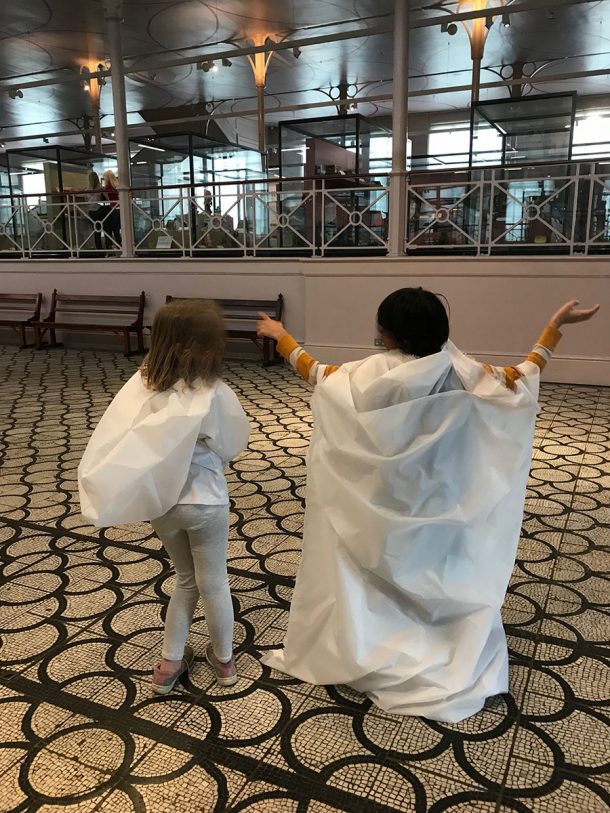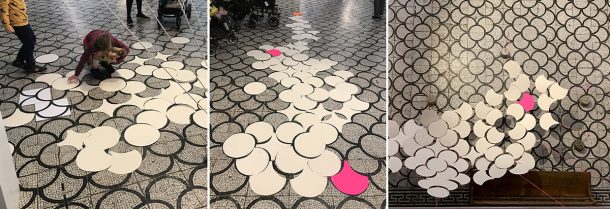I am a Danish architect who specialises in museum and community projects. My residency began with an exploration of outdoor play and reimagined traditional street games, looking to connect the Museum of Childhood with the public through the process of making and play.
Sketching with scissors and drawing with sewing machines.
As a ‘Designer in Residence’ at the V&A Museum of Childhood over the last months I have had the extraordinary opportunity to explore in great depth both the V&A’s sites in South Kensington and Bethnal Green. At the outset of my residency I was keen to explore outdoor play and how the simple acts of running or jumping have increasingly been replaced in our public realm by structured play and sports.
Entering the overwhelming universe of the V&A, a space that seems entirely filled with aesthetically perfect designed objects, I started wondering about the makers and the creative processes behind all these wonderful things. Imagining the many stages they had gone through to reach their perfection worthy of being on show in a museum, I thought about all the possible prototypes, tests, alterations to remove little mistakes and blemishes before each reached the public’s approval.

The False Principle Gallery – process or perfect?
The Victoria and Albert Museum was founded with a mission: to educate designers, manufacturers and the public in art and design. The museum’s first Director Henry Cole declared that the Museum should be a ‘schoolroom for everyone’ and that the museum should take an active part in ‘instructing’ the public on all matters relating to good design. As part of demonstrating to the public what ‘correct’ design and good taste was, one of Cole’s first initiatives was to create a display named the Gallery of False Principles, which contained objects that exemplified what – in his opinion – was considered ‘bad’ design.
The Gallery of False Principles, or ‘Chamber of Horrors’ as it was also called, included a range of everyday decorative objects that Cole felt didn’t meet his standards. The failings of these items were labelled, and placed next to comparative examples of ‘good’ design. Of the 87 original objects shown in the Gallery of False Principles, only 17 have been identified as still remaining in the museum’s collection.

The Gallery of Failures – chance rather than design
My favourite object that remains is Example 87: ‘Chance rather than design’. The label describes a candlestick holder from 1852 as an example of extreme faults that appear to be the result of chance rather than design.
I am curious about this open-ended creative process more than the final product. I am interested in the journey to a solution, and I find this comparable to how the final projects in my profession as an architect mostly feel slightly unfinished to a certain degree: it is the user who takes ownership at the end of the creative process.
To me, failure and learning from mistakes are a big part of the process. In the beginning of any design project I research, conceptualise and plan. But things really start to develop when ideas materialise on paper or cardboard models after they are endlessly improved through the process of making. Likewise, I am often fascinated as much by the back of the objects as the front; it’s a quest to understand the way they were made. The process of making and the story behind an object’s origin can be as valuable as the look of the final product – something rarely on display in museums yet perhaps more important to encourage creative confidence.
I decided to set out to work right in the heart of the Museum of Childhood in my ‘Time for Play’ residency. The stunning marble floor at the centre of the museum became a beautiful canvas and a starting point to explore the building itself and to reveal its stories.
The first play session involved exploring the marble mosaic floor. The floor is made of two types of tiles that are turned and laid in different directions to make four shapes. With young visitors we created simple cardboard shapes to mimic the four tile shapes. We then used these to develop some large labyrinth puzzles by overlaying and matching patterns of the floor. From there, the puzzles became a game – connecting one point to another with creative rules on how to get there!

Since the first play session, I have been sewing together shapes of lightweight fabric, creating ‘wind machines’. The idea is to make large wearable vessels inspired by – and encouraging – movement. There are no ready made patterns for the ‘wind machines’. You draw with your scissors and sketch with a sewing machine to create 3D shapes from 2-dimensional kite fabric. The unexpected shapes then reveal themselves once you run and fill them with air and let them fly. There is an exhilarating feeling of the wind on your body as you run through unusual spaces.
My intention with the studio on the marble floor was for everyone to join in making their own wind machines and fly them – informally connecting the Museum of Childhood with a wider public through the process of making and play. At the same time the on-going makerspace is an opportunity to research how the future residency programme at the Museum of Childhood could best work by talking with the young people it is designed for, rather than talking about them.

Due to the Covid-19 pandemic the collective cutting and sewing of wind machines been postponed for now, and we expect it to take place at a series of locations around London (let me know if you want to join in). In the meantime, I would be curious to hear from young people, or parents, inspired to perhaps create their own wind machines at home. If you do, then please share images of you ‘test flying’ your creations (indoors or outdoors) using @museumchildhood or @galmstrupltd
This residency is supported by the Danish Arts Foundation.
Learn more about Anne Marie’s work and workshops on her website.
Follow her on Instagram.


